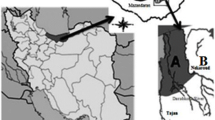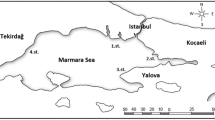Abstract
In the present study, the cadmium, lead, and zinc levels in the blood and shell of Caspian pond turtles (Mauremys caspica) were investigated at five stations in Zarivar International Wetland in Kurdistan Province. All specimens were released at their capture locations within 2 h of capture. Water samples were collected at each station. Heavy metal concentrations were determined using an atomic absorption spectrometer. The mean cadmium, lead, and zinc concentrations were 0.04, 32.10, and 11.45 mg/l in blood samples; 1.82, 16.91, and 89.22 mg/l in shell samples; 0.005, 1.30, and 0.07 mg/l in water samples, respectively. In this study, the highest metal adsorption was zinc and was observed in shell. According to the results of this study, the shell of the Caspian Pond Turtle can be used to estimate the concentration of heavy metals. Our results suggest that Caspian pond turtle can be used as a biological indicator to estimate heavy metals.

Similar content being viewed by others
References
Adel M, Cortés-Gómez AA, Dadar M, Riyahi H, Girondot M (2017) A comparative study of inorganic elements in the blood of male and female Caspian pond turtles (Mauremys caspica) from the southern basin of the Caspian Sea. Environ Sci Pollut Res 24(32):24965–24979. https://doi.org/10.1007/s11356-017-0067-2
Adel MH, Saravi N, Dadar M, Niyazi L, Ley-Quinonez CP (2015) Mercury, lead, and cadmium in tissues of the Caspian Pond Turtle (Mauremys caspica) from the southern basin of Caspian Sea. Environ Sci Pollut Res 24(4):3244–3250. https://doi.org/10.1007/s11356-015-5905-5
Ali H, Khan E, Ilahi I (2019) Environmental chemistry and ecotoxicology of hazardous heavy metals: environmental persistence, toxicity, and bioaccumulation. J Chem 2019, Article ID 6730305. https://doi.org/10.1155/2019/6730305
Allender MC, Dreslik MJ, Patel B, Luber EL, Byrd J, Phillips CA, Scott JW (2015) Select metal and metalloid surveillance of freeranging Eastern box turtles from Illinois and Tennessee (Terrapene carolina carolina). Ecotoxicology 24:1269–1278. https://doi.org/10.1007/s10646-015-1498-5
Barbieri E (2010) Acute toxicity of ammonia in white shrimp (Litopenaeus- schmitti) (Burkenroad, 1936, Crustacea) at different salinity levels. Aquaculture 306(1–4):329–333
Bishop BE, Savitzky BA, Abdel-Fattah T (2010) Lead bioaccumulation in emydid turtles of an urban lake and its relationship to shell disease. Ecotoxicol Environ Safe 73(4):565–571. https://doi.org/10.1016/j.ecoenv.2009.12.027
Cohn B, Wallace B, Grouios C, Dickson B, Scherer R, Kissel A, Gray ME, Jackson TG (2021) Heavy metal concentrations in mojave desert tortoises (Gopherus agassizii) related to a mitigation translocation project, Ivanpah Valley, California, USA. Herpetol Conserv Biol 16(1):128–141
Dos Santos RL, De Sousa Correia JM, Dos Santos EM (2021) Freshwater aquatic reptiles (Testudines and Crocodylia) as biomonitor models in assessing environmental contamination by inorganic elements and the main analytical techniques used: a review. Environ Monit Assess 193:498. https://doi.org/10.1007/s10661-021-09212-w
García-Fernández AJ, Sánchez-García JA, Jiménez-Montalbán P, Luna A (1995) Lead and cadmium in wild birds in southeastern Spain. Environ Toxicol Chem 14(12):2049–2058
Griboff J, Horacek M, Wunderlin DA, Monferran MV (2018) Bioaccumulation and trophic transfer of metals, As and Se through a freshwater food web affected by antrophic pollution in Córdoba, Argentina. Ecotoxicol Environ Safe 148:275–284. https://doi.org/10.1016/j.ecoenv.2017.10.028
Guillot H, Bonnet X, Bustamante P, Churlaud C, Trotignon J, Brischoux F (2018) Trace element concentrations in european pond turtles (Emys orbicularis) from Brenne Natural Park. France Bull Environ Contam Toxicol 101(3):300–304. https://doi.org/10.1007/s00128-018-2376-7
Hillenbrand M (2020) Trace element accumulation and distribution in two turtle species, malaclemys terrapin and chelydra serpentine in New Jersey, USA. Dissertation, Montclair State University
Juncos R, Arcagni M, Squadrone S, Rizzo A, Arribére M, Barriga JP, Battini MA, Campbell LM, Brizio P, Abete MC, Ribeiro Guevara S (2019) Interspecific differences in the bioaccumulation of arsenic of three Patagonian top predator fish: organ distribution and arsenic speciation. Ecotoxicol Environ Safe 168:431–442. https://doi.org/10.1016/j.ecoenv.2018.10.077
Kami HG, Hojati V, Rad SP, Sheidaee M (2006) A biological study of the European Pond Turtle, Emys orbicularis persica, and the Caspian Pond Turtle, (Mauremys caspica caspica), in the Golestan and Mazandaran provinces of Iran. Zool Middle East 37(1):21–28. https://doi.org/10.1080/09397140.2006.10638145
Khan FU, Rahman AU, Jan A, Riaz M (2004) Toxic and trace metals (Pb, Cd, Zn, Cu, Mn, Ni, Co and Cr) in dust, dustfall/soil. J Chem Soc Pak 26(4):453–456
Ley-Quiñónez C, Zavala-Norzagaray AA, Espinosa-Carreon TL, Peckham H, Marquez-Herrera C, Campos-Villegas L, Aguirre AA (2011) Baseline heavy metals and metalloid values in blood of loggerhead turtles (Caretta caretta) from Baja California Sur. Mexico Mar Pollut Bull 62(9):1979–1983. https://doi.org/10.1016/j.marpolbul.2011.06.022
Majnoonian H (2020) National Parks and protected areas, selection of scientific and technical guidelines. Department of Environment, College of Environment, Tehran (in Persian)
Mashroofeh A, Bakhtiari AR, Pourkazemi M, Rasouli S (2013) Bioaccumulation of Cd, Pb and Zn in the edible and inedible tissues of three sturgeon species in the Iranian coastline of the Caspian Sea. Chemosphere 90(2):573–580. https://doi.org/10.1016/j.chemosphere.2012.08.034
Martinez-Lopez E, Gómez-Ramírez P, Espín S, Aldeguer MP, García-Fernández AJ (2017) Influence of a former mining area in the heavy metals concentrations in blood of free-living Mediterranean pond turtles (Mauremys leprosa). Bull Environ Contam Toxicol 99(2):167–172. https://doi.org/10.1007/s00128-017-2122-6
Namroodi S, Zaccaroni A, Rezaei H, Hosseini SM (2018) Evaluating heavy metal contamination effects on the Caspian pond turtle health (Mauremys caspica caspica) through analyzing oxidative stress factors. Int J Epidemiol 5(4): 145–150. https://doi.org/10.15171/IJER.2018.30
Olaifa FE, Olaifa AK, Adelaja AA, Owolabi AG (2004) Heavy metal contamination of Clarias garpinus from a lake and Fish farm in Ibadan, Nigeria. Afric J of Biomed Res 7:145–148. https://doi.org/10.4314/ajbr.v7i3.54185
Paez-Osuna F, Calderón-Campuzano MF, Soto-Jiménez MF, Ruelas-Inzunza JR (2010) Trace metals (Cd, Cu, Ni, and Zn) in blood and eggs of the sea turtle lepidochelys olivacea from a nesting colony of oaxaca, mexico. Arch Environ Contam Toxicol 59:632–641. https://doi.org/10.1007/s00244-010-9516-3
Papathanassiou E (1983) Effects of cadmium and mercury ions and respiration and survival of the common prawn Palaemon serratus (Pennant). Rev Int Oceanogr Med 72:21–35
Qayyum MA, Shah MH (2017) Study of trace metal imbalances in the blood, scalp hair and nails of oral cancer patients from Pakistan. Sci Total Environ 593:191–201. https://doi.org/10.1016/j.scitotenv.2017.03.169
Quiñónez CP, Zavala-Norzagaray AA, Réndon-Maldonado JG, Espinosa-Carreon TL, Canizales-Román A, Escobedo-Urías DC, Aguirre AA (2013) Selected heavy metals and selenium in the blood of Black Sea turtle (Chelonia mydas agasiizzi) from Sonora. Mexico Bull Environ Contam Toxicol 91(6):645–651. https://doi.org/10.1007/s00128-013-1114-4
Ramsar Information Sheet for site no. 2369 (2019), Zarivar, Iran. https://rsis.ramsar.org. Accessed 26 February 2022
Safaei-Mahroo B, Ghaffari H, Fahimi H, Bromand S, Yazdanian M, Najafi Majid E, Yousefkhani M, Rezazadeh E, Hosseinzadeh M, Nasrabadi R, Rajabzadeh M, Mashaykhi M, Moteshari A, Naderi A, Kazemi M (2015) The Herpetofauna of Iran: checklist of Taxonomy, distribution and conservation status. Asian Herpetol Res 6(4):257–290. https://doi.org/10.16373/j.cnki.ahr.140062
Schifer TDS, Junior SB, Montano MAE (2005) Aspectos Toxicológicos Do Chumbo Infarma 17(5–6):67–71
Sheklabadi M, Mahmoudzadeh H, Mahboubi AA, Gharabaghi B, Ahrens B (2014) Long-term land-use change effects on phosphorus fractionation in Zrêbar Lake margin soils. Archives of Agronomy and Soil Science 61(6):737–749. https://doi.org/10.1080/03650340.2014.954106
Slimani T, El-Hassani MS, El-Mouden EH, Bonnet M, Bustamante P, Brischoux F, Brault-Favrou M, Bonnet X (2018) Large-scale geographic patterns of mercury contamination in Morocco revealed by freshwater turtles. Environ Sci Pollut Res 25:2350–2360. https://doi.org/10.1007/s11356-017-0643-5
Smith DL, Cooper MJ, Kosiara JM, Lamberti GA (2016) Body burdens of heavy metals in Lake Michigan wetland turtles. Environ Monit Assess 188(2):128. https://doi.org/10.1007/s10661-016-5118-5
Torabi Kachoosangi F, Karbassi A, Sarang A, Noori R (2020) Sedimentation rate determination and heavy metal pollution assessment in Zariwar Lake. Iran SN Appl Sci 2:1483. https://doi.org/10.1007/s42452-020-03279-9
Vieira LM, Nunes VDS, Amaral MDA, Oliveira AC, Hauser-Davis RA, Campos RC (2011) Mercury and methyl mercury ratios in caimans (Caiman crocodilus yacare) from the Pantanal area Brazil. J Environ Manage 13(2):280–287
Yadollahvand R, Kami HG, Mashroofeh A, Bakhtiari AR (2014) Assessment trace elements concentrations in tissues in Caspian pond turtle (Mauremys caspica) from Golestan province. Iran Ecotoxicol Environ Saf 101:191–195. https://doi.org/10.1016/j.ecoenv.2013.12.028
Yipel M, Tekeli İO, İşler CT, Altuğ ME (2017) Heavy metal distribution in blood, liver and kidneys of Loggerhead (Caretta caretta) and Green (Chelonia mydas) sea turtles from the Northeast Mediterranean Sea. Mar Pollut Bull 25(1–2):487–491. https://doi.org/10.1016/j.marpolbul.2017.08.011
Yu SY, Halbrook RS, Sparling DW, Colombo R (2011) Metal accumulation and evaluation of effects in a freshwater turtle. Ecotoxicology 20(8):1801–1812. https://doi.org/10.1007/s10646-011-0716-z
Zarei F, Hosseini SN, Amini SS, Pezeshk J, Maleki L, Rajabi-Mahan H (2017) Proposing Zarivar Wildlife Refuge (Western Iran) as a Ramsar site based on avian diversity and conservation criteria. Podoces 12(2):27–42
Zavala-Norzagaray AA, Ley-Quiñónez CP, Espinosa-Carreón TL, Canizalez-Román A, Hart CE, Aguirre AA (2014) Trace elements in blood of sea turtles Lepidochelys olivacea in the Gulf of California, Mexico. Bull Environ Contam Toxicol 93:536–541
Acknowledgements
The authors would like to thank Amir Rostami and Masood Mostafa Soltani for their assistance with the blood sampling and Ataolah Tarank, Madeh Hoseini, Salah Dehghani, Fatah Boutimar, Abed Daneshvar, Kamal Rastkhaneh for their assistance with the field surveys. We are grateful to Houshyar Gavilian for his help with conducting the trace elements analysis. We would like to express our gratitude to Semko Azimi, Seyvan Amini, Sharif Bajour, and his wife for their assistance during the fieldwork.
Funding
This work was financially supported by University of Kurdistan.
Author information
Authors and Affiliations
Contributions
All the authors carried out the study conception, design, and material preparation. Elham Moradi collected the data. Elham Moradi and Hanyeh Ghaffari wrote the first draft of the manuscript, and all the authors provided comments on previous versions. All the authors read and approved the final manuscript.
Corresponding author
Ethics declarations
Ethics approval
Not applicable.
Consent to participate
Not applicable.
Consent for publication
Not applicable.
Competing interests
The authors declare no competing interests.
Additional information
Responsible Editor: Philippe Garrigues
Publisher's Note
Springer Nature remains neutral with regard to jurisdictional claims in published maps and institutional affiliations.
Supplementary Information
Below is the link to the electronic supplementary material.
Rights and permissions
About this article
Cite this article
Moradi, E., Ghafari, H. & Ghorbani, F. Heavy metal concentrations in Caspian pond turtle (Mauremys caspica) in Zarivar International Wetland, Kurdistan Province of Iran. Environ Sci Pollut Res 29, 89691–89697 (2022). https://doi.org/10.1007/s11356-022-22056-2
Received:
Accepted:
Published:
Issue Date:
DOI: https://doi.org/10.1007/s11356-022-22056-2




